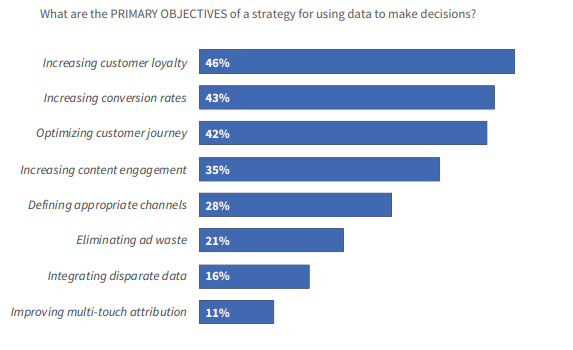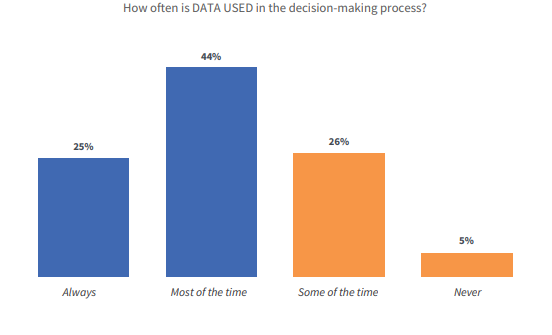Consumers produce mountains of data – we have seen this firsthand in our marketing efforts as we try to wrangle multitudes of data sources into some semblance of order. We know this. Data is produced as consumers research products and services, fill out forms, browse websites, submit reviews, call customer service, place orders, and from any number of numerous activities and interactions. In fact, 2.5 quintillion bytes of data are produced by humans every day. There are 18 zeroes in a quintillion, so that’s a massive amount of data.
There is certainly no shortage of data and marketers are doing their best to manage data insights to drive their marketing initiatives. According to research by Ascend2, nearly one-third (32%) of marketers surveyed report that a strategy is planned to have unified marketing data. Another 45% are already operating with a strategy in place while close to one-quarter (23%) say they have no strategy and no plans to implement one.

Increasing customer loyalty, increasing conversion rates and optimizing customer journey were cited as top objectives for managing data.

According to the research, marketers also reported using data fairly often in the decision-making process. One-quarter (25%) of those surveyed reported that marketing data is used for every strategic decision and another 44% say that data is involved in making decisions most of the time.

In recent research by the Customer Data Platform Institute, more companies are putting systems in place to unify data. More than half (52%) of the 2020 survey respondents reported they connect their data source system to a unified customer database or marketing automation or CRM platform. This is up from 37% in 2017.

Although systems are being implemented, the level of satisfaction with martech investments isn’t rising at the same level. According to the report, “The latest report shows slight improvement: highly satisfied respondents grew from 14% in 2019 to 19% in 2020 and the highly dissatisfied figure fell from 4% to 2%. The average satisfaction score rose very slightly, from 2.57 to 2.62.”

Several factors are leading to this dissatisfaction including the inability to assemble unified data (52%), lack of marketing staff expertise or time (44%) and the inability to use the data in delivery systems (44%).

State of Customer Data Platforms
To combat these challenges, companies have increased their deployed of customer data platforms.
Let’s first start with what a customer data platform is.
Starting with the basic definition, a customer data platform or CDP, is a type of packaged software which creates a persistent, unified customer database that is accessible to other systems. Data is pulled from multiple sources, cleaned and combined to create a single customer profile. This structured data is then made available to other marketing systems. (Wikipedia)
According to David Raab, the founder of the Customer Data Platform Institute (CDPI) and first to coin the phrase:
“A Customer Data Platform is packaged software that creates a persistent, unified customer database that is accessible to other systems”.
This definition has three critical elements:
– “packaged software”: the CDP is a prebuilt system that is configured to meet the needs of each client. Some technical resources will be required to set up and maintain the CDP, but it does not require the level of technical skill of a typical data warehouse project. This reduces the time, cost, and risk and gives business users more control over the system, even though they may still need some technical assistance.
– “creates a persistent, unified customer database”: the CDP creates a comprehensive view of each customer by capturing data from multiple systems, linking information related to the same customer, and storing the information to track behavior over time. The CDP contains personal identifiers used to target marketing messages and track individual-level marketing results.
– “accessible to other systems”: data stored in the CDP can be used by other systems for analysis and to manage customer interactions.
Source: https://www.cdpinstitute.org/cdp-basics
CDP investments have grown sharply in 2020, perhaps as a way to get ahead of the uncertainty caused by COVID-19. In 2017, deployments were at 19% with a decline in 2019 at 17%. In 2020, this number jumped to a 29% deployment.

Additionally, martech satisfaction is highest among firms that have achieved a CDP deployment.

In terms of capabilities a CDP should have, the largest majority of users (80%) agree that data collection ranks as #1.

This is followed by:
- 57% – Powerful identity matching and management
- 43% – Non-technical users can extract customer segments
- 41% – Deliver customer profiles to other systems in real time
The most commonly cited benefit is creation of a unified customer view at 79%. This was followed by improved data analysis and segmentation (64%), improved orchestration of customer treatments across channels (52%), and improved message selection and personalization (46%).

With CDP deployments on the rise, brands clearly see customer data platforms as an opportunity to maintain business growth in this time of economic hardship. Brands must evolve their strategies to get closer to consumers, better understand their intentions, and deliver personalized messaging across multiple channels. CDPs are delivering many competitive advantages for companies and have become a crucial martech asset to stay ahead of the game.






